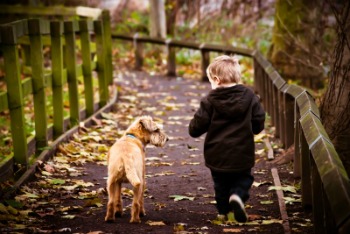 Did you know that young children and pets often respond to stressful situations in a similar manner? Young children often don’t know how to communicate their frustrations, feelings, and what is bothering them. As you know your pets can’t communicate but they often communicate using their body language. We have three dogs in our house and I am thankful that they get along fairly well with my children. However, the dogs will let my toddler know when they have had enough. I always supervise my toddler very closely when he is playing with the dogs so that I can run interference for the dogs. Today I wanted to share with you some tips and suggestions from Skousen, Gulbrandsen and Patience PLC, an attorney’s office that specializes in personal injury and dog bite cases, to help you understand how your child and pets respond to stressful situations. If your dog or cat feels threatened, they could act out and bite your child or a visitor in your home.
Did you know that young children and pets often respond to stressful situations in a similar manner? Young children often don’t know how to communicate their frustrations, feelings, and what is bothering them. As you know your pets can’t communicate but they often communicate using their body language. We have three dogs in our house and I am thankful that they get along fairly well with my children. However, the dogs will let my toddler know when they have had enough. I always supervise my toddler very closely when he is playing with the dogs so that I can run interference for the dogs. Today I wanted to share with you some tips and suggestions from Skousen, Gulbrandsen and Patience PLC, an attorney’s office that specializes in personal injury and dog bite cases, to help you understand how your child and pets respond to stressful situations. If your dog or cat feels threatened, they could act out and bite your child or a visitor in your home.
Are there things you know now that you wish you were aware of many years before? Whether you were forewarned and disregarded the knowledge about a certain problem, or whether it was something painful you had to learn from experience (however painful it might have been), hindsight can always help to clarify many different situations.
Children and Pets Can Have an Amazing Bond
When raising children and pets, although it is obviously a wonderful time, it is also full of its fair share of turbulence and trouble as well. For example, you may have observed that raising children or pets that are close together in age creates more of a bond than those with a notable age gap. Age, size, and other personal characteristics can play a part in the connectivity that kids or pets develop with each other.
Childhood and Pet Syndromes and Coping Characteristics
Psychologists and therapists have talked for many years about different childhood syndromes and coping characteristics. For example, in a household with more than two children, the second-born is likely to show signs of “middle child syndrome”, where they often feel neglected and a lack of respect from their siblings. They also suffer from a higher risk of acting out and causing ripples in the family unit. This includes but is not limited to temper tantrums, an association with groups of friends that are unaccepted by the family, and a palpable level of disrespect towards themselves, others, and their possessions (whether it is theirs or someone else’s).
The same applies to your pets. Take dogs as an example. Having one puppy will often provide someone close in age and of the same gender with a great degree of companionship. However, adding more dogs into the dynamic may result in “middle pet syndrome,” and you may notice puppy B acting out. This can manifest itself as something as simple as not eating, tearing up toys so that others cannot play with them, or hoarding toys and/or food.
Comments
2 responses to “Learn How Young Children and Pets Respond to Stressful Situations”
I’ve often been struck with how similar children and dogs can be. I like to think I know a lot about dogs, but even I learned some things from this article! Thank you!
This is a very interesting take on children and animal behavior. Thank you for sharing!